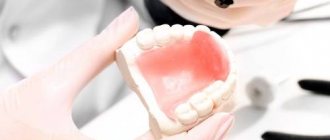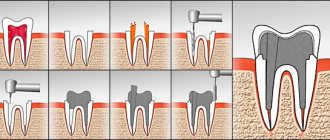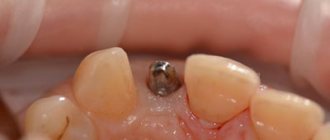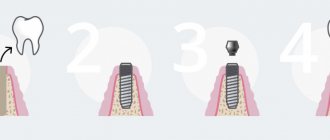A patient came to us with a 3.5 tooth. This is a pulpless tooth - the lower five, it does not have any periapical changes or inflammation in the area of the root apex. On the tooth there is a lack of the upper half of the coronal part of the tooth, that is, the upper half. On tooth 3.5
Initially there was a filling, a metal stump insert was installed in the tooth, it was quite deep, and a filling was already installed on top.
Here's a “puff sandwich”:
The filling “safely” broke off from the metal dental inlay. Metal generally does not have the best adhesion both to the tooth and to fillings and ceramic structures. The tooth also had numerous caries.
Naturally, the decision was immediately made to make the tooth new, that is, to update this tooth by installing a ceramic inlay using CEREC technology. Within two minutes, the metal insert was removed from the tooth.
How to remove a metal tab
If the metal dental inlay is single-rooted or double-rooted, then a small notch is made in the form of a step and the metal inlay is removed from the tooth using gentle kinetic movements and tapping.
Since metal has poor adhesion to the root, to fillings and to ceramics, it can be completely removed with almost the slightest tap, absolutely naturally, without breaking. As a result of atraumatic extraction, the bone was preserved, nothing cracked: neither the root nor the remaining bone structure. I can add that not once, in all the years I have been removing metal tabs in this way, has anything cracked, and I always remove all the tabs from a tooth in literally two minutes. It's just all about experience.
Making a tab for Cerek:
- removed the tab, leveled the root, removed caries:
- prepared the tooth for the manufacture of the missing module in the form of the crown part of the tooth with the root part together monolithically.
- scanned the tooth
- created a tab model on CEREC:
- perfect color choice,
- made a tab,
- tried the inlay on the tooth:
Installing a ceramic inlay
The color of the ceramic inlay matched very nicely. Next, I glazed the CEREC inlay and fixed the manufactured inlay to our patient. And as a result, the patient received in 1.5 hours
, consisting of only
two parts
:
- the first part is your tooth (root)
- the second part is the missing ceramic module.
Two parts and one connecting seam in the form of cement:
Manufacturing and installation
The procedure for creating a simple stump inlay is quite complex from a technical point of view, and involves several sequentially implemented stages.
The first stage involves preparing the unit, from which excess and diseased tissue is removed. The main task is to ensure parallel passage of the polymer mass, which is poured after processing, forming an anatomically accurate cast.
The second stage is using the resulting base to create a tab. As a rule, metal ceramics are chosen as the material for the workpiece - the most balanced option in terms of price and quality ratio.
The final stage is installation and fixation. The newly formed bite must be checked to eliminate errors and possible defects that cause inconvenience to the patient.
Price
The price of a stump tab depends on its type, material and the specifics of a particular clinical case. In modern dentistry, the use of the technique is becoming increasingly popular, so the option is offered by most medical institutions. The cost of a comprehensive service in our clinic starts from 6,500 rubles.
Advantages of a Cerek inlay over a metal dental inlay
Benefit #1. Physical.
If we compare the CEREC inlay with a metal inlay, then the Cerec solution is much better in terms of the physical strength of the structure than the “tooth + metal inlay + crown” model, since these are three components that connect two seams.
Benefit #2. Aesthetic.
If there is metal in the tooth, then it is almost impossible to use metal-free structures because:
- firstly,
there will be poor adhesion, - secondly,
metal always shines through a little.
Let me explain advantage #2:
When using metal inlays, it is impossible to make a natural tooth color similar to nature, because If you make a ceramic crown on top, the metal inlay will shine through it, since high-quality ceramics have the transparency of your own tooth. And if you put a crown made of zirconium dioxide, the inlay will not be visible through it, but you will immediately see that the tooth is not your own, because Zirconium is very dense in itself and matte. Any structures made from solid ceramics have some transparency, which is also inherent in our natural teeth. Therefore, today we always extract any metal from a tooth. This is always done very simply if you have the appropriate experience.
Benefit #3. Chemical.
Metal is also the cause of galvanism
. There are laws of chemistry associated with dissimilar metals. And in our case, such metals are located in the oral cavity. If two different types of metal are installed in the oral cavity, for example, nickel, various cobalt-chromium alloys, molybdenum alloys - and if these are different metals, then a phenomenon called galvanism can occur in the mouth.
That is, chemical ionic bonds arise between these metals, which lead to periodontitis. Therefore, ideally, there should be no metal in the mouth at all.
Tabs lifespan
How long the inlays will last depends largely on the initial condition of the tooth. If a sufficient number of supports have been preserved to fix the prosthesis (that is, not only the base of the cavity, but also the walls of the tooth), its installation was carried out professionally, then the composite inlay will last from 3-4 years, ceramic or zirconium - from 10 years or more. Proper care of the restored tooth is also important (it is necessary to prevent the development of caries, since in this case the inlay will have to be removed and redone).
Regular care and periodic preventive examinations at the dentist will help extend the service life, the purpose of which is to assess the condition of the tooth and the quality of the fit of the prosthesis.
Rules for caring for restored teeth
Caring for inlays is no different from standard hygiene procedures for oral care (brushing teeth, rinsing after meals). Do not overuse dental floss, as too much pressure can cause the inlays to chip. An irrigator will be a useful hygiene product - at home it will help clean hard-to-reach places and massage the gums.
Read detailed instructions on how to care for teeth with inlays installed >>>
RESULT OF TREATMENT:
In our case, when the metal inlay was removed, a ceramic module was installed on the tooth root in one step on a fresh surface. The duration of the entire work is only (!) 1.5 hours
.
The patient is incredibly satisfied, and the tooth is very beautiful and aesthetic. And most importantly - very reliable
.
CEREC inlays instead of metal inlays are a super motivational treatment in my opinion. And, according to many of my patients, nothing can be cooler than this treatment
.
Author:
Sergey Samsakov, orthopedic dentist was born on 02/02/1989.
Education:
2011 — Graduated from the Moscow State Medical and Dental University named after. A.I.Evdokimova
2012 — Internship in the specialty “Orthopedic Dentistry”, Moscow State Medical University named after. A.I.Evdokimova
2014 - Residency in Orthopedic Dentistry, Moscow State Medical University named after. A.I.Evdokimova
Types of pins and features of their extraction and root canal
According to the material of manufacture, the pins are:
- Fiberglass - made from woven glass fibers that are arranged in a horizontal plane and embedded in an epoxy matrix. They are quite durable, and their physical characteristics are as close as possible to the native tooth tissues. For these reasons, they are used for restorations of frontal units. They do not show through the crowns, and their removal is not very difficult;
- Anchor - made of titanium, precious metals or stainless steel. Thanks to their special properties, it becomes possible to reconstruct even an almost completely destroyed unit, provided that its root is well preserved. They are fixed in the canal using phosphate cement. Destruction of the latter is possible only with the use of ultrasonic waves;
- Parapulpal – made of dental stainless steel with a polymer coating. They are used to strengthen fillings and are installed directly into hard dental tissues, which eliminates the risk of infection or inflammation. At the same time, the proximity of their location to the surface leads to the fact that they break teeth and require re-installation. To remove them, the dentist drills out a small amount of hard tooth tissue around it with a drill, and then carefully unscrews the structure.
Anchor pins are most often removed due to the development of secondary caries, but situations are possible when it is displaced during the process of chewing food and causes damage to the prosthesis. In the latter case, you will have to replace the entire structure, sometimes correction is possible. Unfortunately, it happens that violations are detected at a stage when treatment of the unit will not give the desired result - it is only possible to remove it along with the pin.
More examples of treatment
Depulped tooth Caries of the tooth root Destruction of the canine on the lower jaw
Replace the anchor pin with a CEREC tab
The front wall of the fang is made in the form of a filling, which has fallen apart from the cutting edge, darkened and is aesthetically unattractive. There is an anchor pin inside the tooth.
CEREC inlay for anterior tooth Removal of anchor pin Professional hygiene
more details
Depulped tooth Caries under filling Absence of the crown part of the tooth
Restoration of the seventh lower tooth 4.7 with a CEREC inlay
Patient Oleg A., 53 years old, came to me for help. Prior to this, the patient’s seventh lower tooth 4.7 was previously depulped and a temporary Septo-pack filling was installed. The tooth canal was filled with gutta-percha.
Module crown + tooth root CEREC
more details
Indications for removing the stump tab, pin, dental instruments from the canal
Removing a post, onlay or endodontic file from a root canal while keeping the tooth suitable for prosthetics is not an easy task. It requires the dentist to have skill and experience in carrying out such manipulations, as well as the availability of appropriate tools and equipment. The procedure is carried out in several stages and requires the removal of a denture or filling, if they have been installed. Only after this can you begin to directly remove the fiberglass pin from the tooth or any other structure. Indications for the procedure:
- Violations committed by the dentist during treatment;
- Development of inflammatory processes in the root area and periodontal tissues;
- Development of caries and pain in the patient;
- Destruction of the dental unit under the crown.
As for fragments of endodontic instruments, the patient does not experience any unpleasant sensations when they come into contact with them. They appear much later and are manifested by the following symptoms:
- Discomfort and pain when biting on a tooth and chewing;
- Swelling of the gums in the area of the recently treated tooth;
- The appearance of a fistula in the oral cavity;
- Suppuration of soft tissues.
The above is a reason to promptly seek professional dental care. The dentist will prescribe a visiography, which will help identify foreign objects in the filled tooth. Thanks to it, it will be possible to establish the presence of caries or inflammation.
Particles from endodontic instruments must be removed, as they begin to rust and irritate the canal walls. As a result, the tooth root may crack and the tooth will have to be completely removed, since restoration in such a situation is not possible. Removing the instrument from the tooth canal is also necessary because:
- It will not allow it to be sealed properly, and as a result, the procedure will have to be carried out again;
- Its presence inside the canal is the cause of the development of serious inflammatory processes (if a fragment of a necrotic nerve remains under the fragment, it will rot).
It is for these reasons that refilling of root canals is carried out only after removing the instrument from the root canal.
Do you want to restore a tooth with a ceramic inlay?
Always at your service - Sergey Samsakov, orthopedic dentist with more than 10 years of successful experience, Moscow. Expert in 3D digital smile modeling, veneers and CEREC technology.











